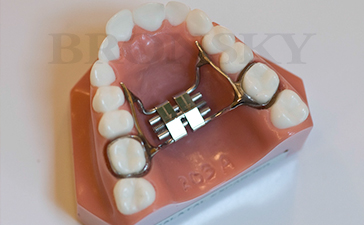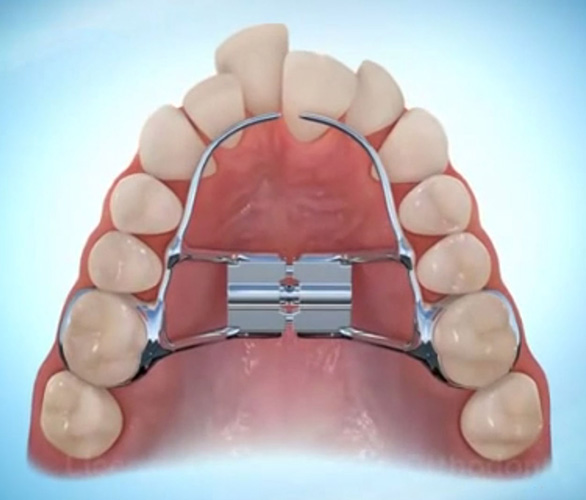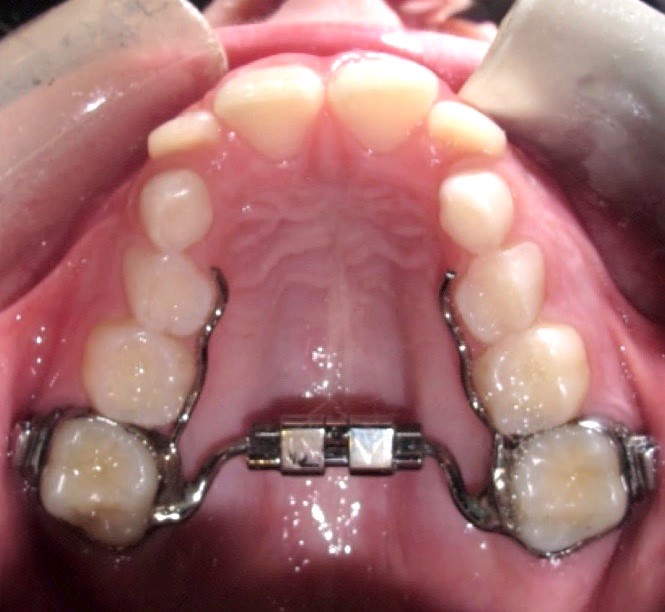Expander orthodontics is a specialized treatment used to correct dental and skeletal issues in the upper jaw. It is a non-surgical procedure that involves the use of an orthodontic appliance called an expander. This appliance is custom-made to fit the patient’s mouth and is designed to gradually widen the upper jaw.
Overall, expander orthodontics is a safe and effective treatment option for correcting dental and skeletal issues in the upper jaw. It can help improve the alignment of the teeth, create a more balanced facial appearance, and enhance overall oral health. If you or your child are experiencing dental issues related to a narrow upper jaw, it may be worth considering expander orthodontics as a potential treatment option.
Expander orthodontics is a treatment method used to correct certain dental issues, such as narrow dental arches and crossbites. It involves the use of an orthodontic appliance called an expander, which is designed to widen the upper jaw or the palate.
The expander works by applying gentle pressure on the bones and sutures of the upper jaw, gradually expanding them over time. This expansion creates more space in the dental arch, allowing the teeth to align properly and improving the overall bite.
During the initial consultation, the orthodontist will assess the patient’s dental condition and determine if expander orthodontics is the appropriate treatment option. X-rays and dental impressions may be taken to evaluate the jaw structure and plan the expansion process.
Once the expander is fitted, the patient will need to activate it regularly as instructed by the orthodontist. This is usually done by turning a small key located on the expander, which gradually widens the appliance and applies pressure on the upper jaw.
Expander orthodontics can provide numerous benefits, such as improving the aesthetics of the smile, enhancing facial symmetry, and correcting breathing and speech problems caused by dental issues. It can also create more space for crowded teeth, reducing the need for tooth extraction in some cases.
Overview of Expander Orthodontics
Expander orthodontics is a treatment method used by orthodontists to correct dental issues such as crowding, crossbites, and narrow arches. It involves the use of a dental appliance called an expander to widen the upper jaw and create more space for the teeth.
This treatment is typically recommended for children and teenagers whose jaws are still growing and can be easily manipulated. Expander orthodontics can also be used in some cases for adults, although the effectiveness may vary depending on the individual’s age and jaw development.
How Does Expander Orthodontics Work?
The expander appliance is custom-made and is typically attached to the upper molars using bands or cemented to the roof of the mouth. It consists of two halves that are connected in the middle by a screw-like mechanism. By turning the screw, the orthodontist gradually increases the width of the appliance, which in turn applies gentle pressure on the upper jaw.
Benefits of Expander Orthodontics
Expander orthodontics offers several benefits for individuals with narrow arches or dental crowding. Some of the main benefits include:
- Improved dental alignment: Expander orthodontics can help create more space for crowded teeth, allowing them to align properly.
- Enhanced facial symmetry: By widening the upper jaw, expander orthodontics can improve the overall facial symmetry and balance.
- Improved breathing and speech: Expander orthodontics can help alleviate breathing issues and speech problems that may be caused by a narrow upper jaw.
Conclusion

Expander orthodontics is an effective treatment method for correcting dental issues related to narrow arches and crowding. By using a custom-made expander appliance, orthodontists can gradually widen the upper jaw and create more space for the teeth. This treatment offers several benefits, including improved dental alignment, enhanced facial symmetry, and prevention of future dental problems. If you or your child have dental issues that may be addressed with expander orthodontics, it is recommended to consult with an orthodontist to determine the best treatment plan.
Benefits of Expander Orthodontics
Expander orthodontics is a dental treatment that offers several benefits for patients. Here are some of the key advantages of using expander orthodontics:
1. Corrects Dental Misalignment
One of the primary benefits of expander orthodontics is its ability to correct dental misalignment. By gently widening the upper jaw, expanders can help align the teeth properly, improving both the appearance and function of the smile.
2. Resolves Breathing Issues

Expander orthodontics can also be beneficial for patients who have breathing issues, such as sleep apnea or chronic snoring. By expanding the upper jaw, it creates more space in the airway, allowing for improved airflow and reducing the symptoms associated with breathing difficulties.
3. Enhances Facial Symmetry

By correcting dental misalignment and expanding the upper jaw, expander orthodontics can also help enhance facial symmetry. This treatment can improve the overall balance and proportions of the face, resulting in a more aesthetically pleasing appearance.
4. Prevents the Need for Extraction
In some cases, expander orthodontics can eliminate the need for tooth extractions. By creating more space in the mouth, expanders can help accommodate all the teeth, reducing the likelihood of overcrowding and the need for removal of healthy teeth.
5. Improves Bite Function
Expander orthodontics can also improve bite function by aligning the upper and lower jaws properly. This can help alleviate issues such as an overbite, underbite, or crossbite, allowing for more efficient chewing and reducing the risk of jaw pain or temporomandibular joint (TMJ) disorders.
Overall, expander orthodontics offers a range of benefits for patients, including improved dental alignment, enhanced facial symmetry, better breathing, prevention of tooth extraction, and improved bite function. Consult with an orthodontist to determine if expander orthodontics is the right treatment option for your specific needs.
How Expander Orthodontics Works
Expander orthodontics is a dental treatment that aims to widen the upper jaw and create more space for crowded teeth. It is commonly used in children and teenagers who have narrow dental arches and crowded teeth. The treatment involves the use of an expander, which is a device that is placed in the mouth and gradually widens the upper jaw.
Step 1: Consultation and Examination
The first step in the expander orthodontic treatment process is a consultation and examination with an orthodontist. During this visit, the orthodontist will evaluate the patient’s dental and facial structure, take X-rays and impressions of the teeth, and determine if the patient is a suitable candidate for expander orthodontics.
Step 2: Customization and Placement of the Expander
If the orthodontist determines that the patient can benefit from expander orthodontics, a customized expander will be created. The expander is usually made of metal or plastic and is designed to fit the patient’s mouth. The orthodontist will then place the expander in the mouth and secure it to the upper molars using bands or cement.
Step 3: Activation and Adjustment
Once the expander is in place, the orthodontist will provide instructions on how to activate and adjust the expander. This is typically done by turning a screw or key in the expander, which gradually widens the device and puts pressure on the upper jaw. The patient or their parent will need to perform these adjustments as directed by the orthodontist.
Step 4: Monitoring and Follow-up Visits
Throughout the treatment process, the orthodontist will closely monitor the progress of the expander orthodontics. Follow-up visits will be scheduled to check the expansion of the upper jaw, make any necessary adjustments to the expander, and ensure that the treatment is proceeding as planned.
Step 5: Completion of Treatment

Once the desired expansion of the upper jaw has been achieved, the expander will be removed. At this point, the orthodontist may recommend additional orthodontic treatment, such as braces, to further align the teeth and create a beautiful smile.
Overall, expander orthodontics is a highly effective treatment for correcting narrow dental arches and crowded teeth. It works by gradually widening the upper jaw, creating more space for the teeth to align properly. With proper monitoring and follow-up care, patients can achieve a straighter and healthier smile.
Types of Expanders Used in Orthodontics
There are several types of expanders used in orthodontics to correct dental issues and create more space in the mouth. These expanders work by applying gentle pressure to certain areas of the jaw, allowing the bones and tissues to gradually move and create additional space.
1. Palatal Expander
A palatal expander is a commonly used type of expander that is placed on the roof of the mouth. It consists of two halves that are connected in the middle by a screw-like mechanism. By turning the screw, the two halves of the expander gradually move apart, widening the upper jaw and creating more space for the teeth.
2. Rapid Maxillary Expander (RME)
![]()
3. Quad-Helix Expander

The quad-helix expander is a fixed expander that is cemented to the upper molars. It consists of a wire framework with four helical springs that put pressure on the molars, gradually expanding the arch. This type of expander is often used to correct crowding and narrow arches.
4. Haas Expander
The Haas expander is similar to the quad-helix expander, but it uses acrylic pads instead of helical springs. The pads apply pressure to the molars, widening the arch and creating more space. The Haas expander is often used to correct posterior crossbites and expand the upper jaw.
5. Hyrax Expander
The hyrax expander is a popular type of expander that is used to widen the upper jaw. It consists of a metal framework with a screw in the middle. By turning the screw, the two halves of the expander move apart, gradually expanding the upper jaw and creating more space for the teeth.
| Type of Expander | Function |
|---|---|
| Palatal Expander | Widens the upper jaw |
| Rapid Maxillary Expander (RME) | Corrects crossbites and narrow upper jaws |
| Quad-Helix Expander | Corrects crowding and narrow arches |
| Haas Expander | Corrects posterior crossbites and expands the upper jaw |
| Hyrax Expander | Widens the upper jaw |
What to Expect During Expander Orthodontic Treatment

Expander orthodontic treatment is a process that involves the use of a dental appliance called an expander to widen the upper jaw. This treatment is commonly used in orthodontics to correct issues such as a narrow palate, crossbite, or crowded teeth.
When you undergo expander orthodontic treatment, there are several things you can expect:
- Initial consultation: The first step in expander orthodontic treatment is an initial consultation with an orthodontist. During this appointment, the orthodontist will evaluate your dental condition and determine if an expander is the right treatment option for you.
- Impressions and X-rays: If an expander is recommended, the orthodontist will take impressions of your teeth and jaw to create a custom expander. X-rays may also be taken to assess the position of your teeth and jaw.
- Placement of the expander: Once the custom expander is ready, it will be placed in your mouth by the orthodontist. The expander may be fixed or removable, depending on your specific treatment plan.
- Adjustments: After the expander is placed, you will need to visit the orthodontist regularly for adjustments. During these appointments, the orthodontist will use a special key to gradually widen the expander. This process applies gentle pressure to the upper jaw, gradually expanding it over time.
- Discomfort: It is common to experience some discomfort or pressure in the initial days after the expander is placed or adjusted. This discomfort should subside as your mouth adjusts to the appliance.
- Speech changes: The expander may temporarily affect your speech, causing a slight lisp or changes in the way you pronounce certain words. With time, your speech will adjust, and these changes will resolve.
- Dietary restrictions: Certain foods may need to be avoided during the treatment period to prevent damage to the expander. Your orthodontist will provide a list of foods to avoid and recommend a diet that is safe for the expander.
- Duration of treatment: The duration of expander orthodontic treatment varies depending on the individual case. Typically, the treatment can last anywhere from a few months to a year or more.
- Follow-up care: Once the desired expansion is achieved, the expander will be removed by the orthodontist. However, this is not the end of the treatment. You may still need to wear braces or other orthodontic appliances to further align your teeth and achieve optimal results.
- Maintenance: After the expander is removed, you will enter the maintenance phase of your orthodontic treatment. This may involve wearing retainers to ensure that the expansion achieved is maintained and to prevent any relapse.

Dr. Fidel Cann: Esteemed orthodontist with a lifelong dedication to enhancing smiles and oral health. Pioneering expertise, compassionate care.





